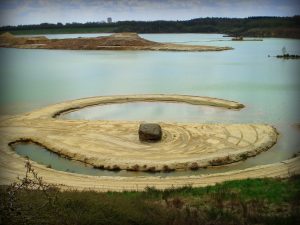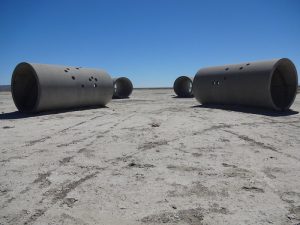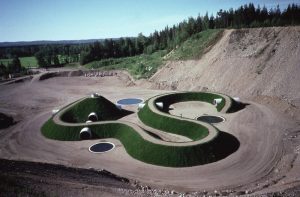Cosmic Imitations – Calix Plaza
Calix Plaza
Cosmic Imitations
By Calix Plaza



Preface: My name is Calix Plaza and my portfolio is titled Cosmic Imitations. I will be publishing my work using a CC BY-NC-ND license.
Introduction
Cosmic Imitations is about the use of the land art movement, which utilizes both the land and manmade materials to create truly intriguing works. Specifically, this portfolio is about shining light on the photographic and compositional works of the late couple Robert Smithson and Nancy Holt, which revolves around space and the reflection of its structural beauty on Earth. These works enable the audience to not only admire the beautiful representation of these interstellar patterns, but also appreciate the environment friendly construction of these artworks.
Themes
The two key themes that will be addressed in this portfolio are nature and space. Smithson and Holt’s works perfectly capture both of these themes, as they feature both gorgeous natural settings and unique representations of cosmic bodies. Undoubtedly, land art relies on the natural world to create beautiful artworks, by shaping the land and/or adding sculptures while still preserving its integrity. These long lasting works by Smithson and Holt allow nature to return to a natural state after their construction, as plants and fungi begin to grow and animals find homes on the land. The settings of these works are removed from human interaction, from a Dutch lake to the middle of a barren desert. These works respect the land and nature, and inspires viewers to do the same. Not only is nature present in these works, but also the theme of space. By space, I am referring to the cosmos, the vast sea of stars and galaxies that these works channel as well. These works take beautiful cosmic features and bring them down to Earth, for the world to appreciate.
Analysis
The first work to be discussed is Robert Smithson’s Broken Circle, crafted in 1971 on the shoreline of a sand quarry. The work can be found in Emmen, Netherlands, and was Smithson’s only land artwork to be constructed outside of the United States. Smithson has always been fascinated by the cosmos, as his previous land art Spiral Jetty featured the shape of a spiral galaxy. Broken Circle is a little closer to home however, as it is in the shape of a barred spiral galaxy, the same shape as our own Milky Way galaxy. In the center of Smithson’s work is a large boulder, where the bright astronomical radio source Sagittarius A* is found at the center of our galaxy. Curiously, this source wasn’t discovered until three years after the completion of Broken Circle, but every spiral must eventually lead somewhere which is something Smithson truly embraced. The second work was by Smithson’s partner, Nancy Holt. It is titled Sun Tunnels, and its construction took place between 1973 and 1976. It is in the Great Basin Desert, in Utah. The work is made up of four concrete tunnels, which are arranged to align with both the sunrise and sunset during the summer and winter solaces. In addition, each tunnel features a series of small holes that casts light in the shape of four constellations: Draco, Perseus, Columba, and Capricorn. These constellations appear whenever the sun is out, and does an amazing job linking the distant stars to our own planet. The last of these three works is also by Holt, and can be found in Pinsiö, Finland. This work is titled Up and Under, and was constructed from 1987 and 1998. It is composed of a winding mound of earth and grass, with three reflective pools. Within the earth are seven horizontal tunnels and a single vertical tunnel, which are aligned with the star Polaris, also known as the North Star. This work was created as part of a project to restore the land of an old Finnish sand quarry, a similar setting to her husband Smithson’s Broken Circle. The beautiful design of grass and soil combined with the alignment of Polaris creates a unique piece of art which links both nature and outer space, just as her partner had done with his works.
Application
On its own, land art is a highly unique art form with a genuine purpose. Its purpose is to show the world the true beauty of our planet, and inspire people to take care of it. Artists are able to create amazing sculptures without causing irreversible damage to the land, in the way that a skyscraper or a metal monument would. While these buildings may be appealing to the eye, they are unable to inspire the same awe that a minimalistic artwork sculpted out of our very own planet would. Land art shows us where we lie in the universe and reminds us that we must protect our home at all costs. Holt and Smithson’s land art took that purpose to a new extreme, by introducing cosmic patterns in the shape of galaxies, constellations, and stars, including our own Sun. It links both the unique nature of our planet and the incredible design of celestial bodies. Space is full of nature, just a different nature from what we down on Earth would understand. The birth of stars, the formation of galaxies, these are just as much nature as a butterfly emerging from its cocoon to take flight for the first time. These works enable us to appreciate not only the landscape of our own planet, but also what lies far beyond our solar system.

